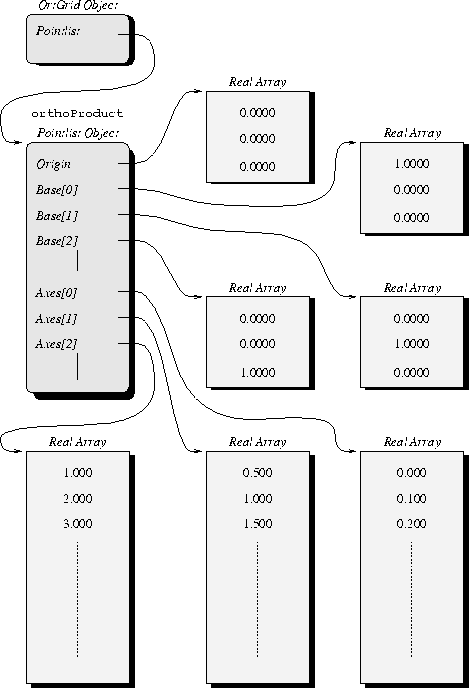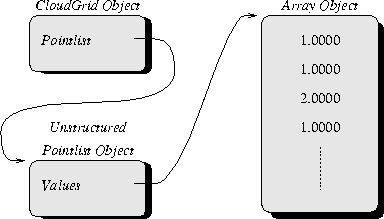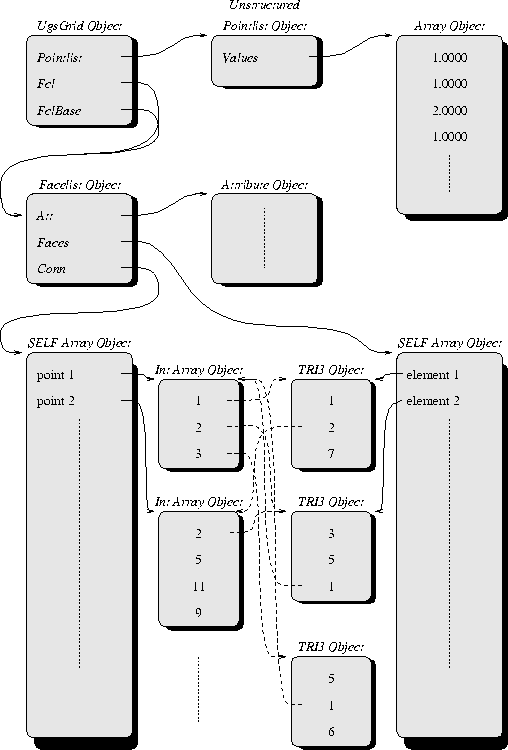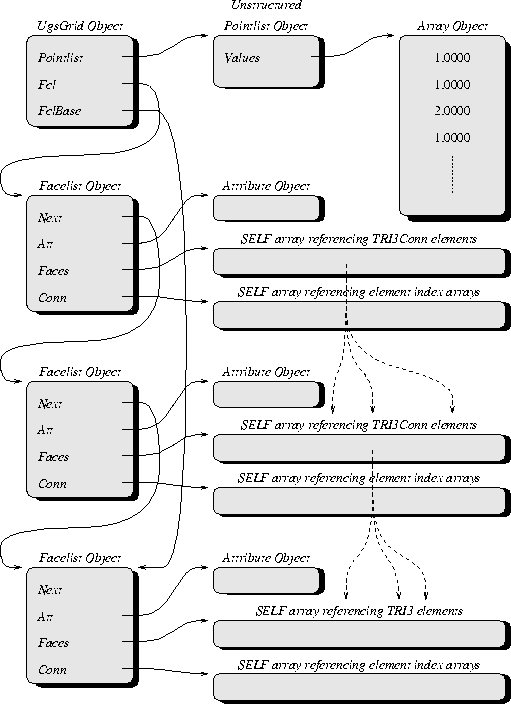The Grid Classes




Next: The Point List
Up: 7.1.1 Architecture
Previous: The Attribute Class
GRS distinguishes between three different grid types, namely tensor product
grids, unstructured grids, and point cloud grids. All three classes are
derived from a common generic grid class, which contains a grid type
identifier set to one of the three types upon grid reading. An application now
can easily determine the type of the grid under consideration by examining
this grid type identifier.
An additional GRS object pointer to a point list object is also defined by
this generic grid class, which then can be used to represent point cloud grids
and tensor product grids as well: These grids contain just a PIF point list
object, which is an orthoProduct in case of a tensor product grid, and
an unstructured point list in case of the point cloud grid. Therefore this
pointer will point to a GRS ortho product point list object in the case of
a tensor product grid, and to a GRS unstructured point list object in the
case of a point cloud or unstructured grid. While this multiple use of one
class definition for many logically different purposes will most probably be
rejected by a rigid advocate of pure object-orientedness, this approach is
most practical from the PIF point of view and simplifies the definition of
corresponding methods considerably.
Since an unstructured PIF grid contains additional information about the
grid elements, a separate unstructured grid class is derived from the generic
grid class. Two members besides the inherited ones are contained in this
class, both of which are GRS object pointers to GRS face list objects
see page  of the unstructured grid. In the case of a hierarchical
unstructured grid, one of these pointers points to the base hierarchy, and the
other to the highest hierarchy of the unstructured grid. For non-hierarchical
unstructured grids, both pointers point to the (only) base hierarchy of the
unstructured grid.
of the unstructured grid. In the case of a hierarchical
unstructured grid, one of these pointers points to the base hierarchy, and the
other to the highest hierarchy of the unstructured grid. For non-hierarchical
unstructured grids, both pointers point to the (only) base hierarchy of the
unstructured grid.
A few figures shall illustrate the various grid representations of GRS:
Fig. 7.4 shows a tensor product grid referencing an orthoProduct point list. A point cloud grid would be stored as
shown in Fig. 7.5. Unstructured grids can be either plain ones or
hierarchical ones. Fig. 7.6 shows a plain unstructured grid, whereas
Fig. 7.7 shows a hierarchical unstructured grid consisting of TRI3 elements on the lowest level and TRI3Conn elements on the higher
hierarchy levels.

Figure: Tensor product grid
object. Only members of pointer type are shown. All rectangles with sharp
corners represent simple allocated C arrays rather than GRS objects,
drawn as rectangles with round corners. Both the origin and the base vectors
are stored in allocated real arrays. In this case the origin vector has three
values, hence the grid lies in three-dimensional space. There are three
orthonormal base vectors, hence we have also have a grid with three
topological dimensions spanning a three-dimensional cube. The tick values
finally are stored in the grid axes real arrays.

Figure: Point cloud grid object.
Only members referencing other objects are shown. Since a point cloud grid is
just a set of points, an unstructured point list object is used to represent
the grid.

Figure: Unstructured
grid object. Only members referencing other objects are shown. Solid lines
denote reference by pointer while dashed lines denote reference by index.

Figure: Hierarchical unstructured grid object. Only members referencing other
objects are shown. The Faces and Conn structures are simplified
for clarity. Solid lines denote reference by pointer while dashed lines denote
reference by index. An example element hierarchy branch is shown in the
connectivity arrays.
Due to the importance of grids in general for all TCAD applications,
functional support for the grid classes is crucial. This support can be
divided into two categories: Element-wise reading and writing of unstructured
grids see Section 7.1.2, and complete reading and writing into and
from object representations for interpolation or in-memory manipulation.
see Section 7.1.2, and complete reading and writing into and
from object representations for interpolation or in-memory manipulation.
Interpolation requires that the grids are hold in memory for fast access to
individual grid points or elements. Therefore read functions exist, that read
a PIF grid into a corresponding GRS grid object as discussed above. But
interpolation requires further preparation of the grid, which is discussed in
more detail in Section 7.1.3.




Next: The Point List
Up: 7.1.1 Architecture
Previous: The Attribute Class
Martin Stiftinger
Tue Nov 29 19:41:50 MET 1994
 of the unstructured grid. In the case of a hierarchical
unstructured grid, one of these pointers points to the base hierarchy, and the
other to the highest hierarchy of the unstructured grid. For non-hierarchical
unstructured grids, both pointers point to the (only) base hierarchy of the
unstructured grid.
of the unstructured grid. In the case of a hierarchical
unstructured grid, one of these pointers points to the base hierarchy, and the
other to the highest hierarchy of the unstructured grid. For non-hierarchical
unstructured grids, both pointers point to the (only) base hierarchy of the
unstructured grid.








